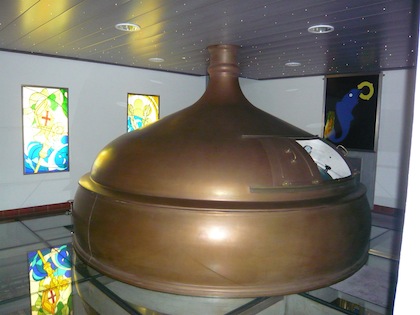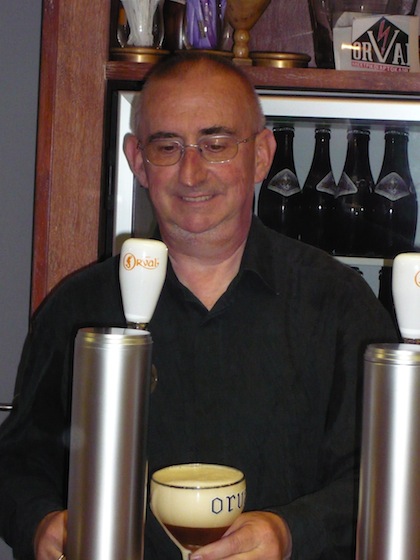Starry, starry night. The light is low in Orval’s brew house, giving its trinity of copper-clad lauter tuns and kettle the glow of a late sunset, while pinpricks of light adorn the ceiling, the first evening stars. A simple wooden cross hangs on the wall. Colored glass panels featuring devotional scenes add to the sense of contemplation and transcendence. The whole effect is of something more than a place where beer is brewed.
Trappist beers are the original collaboration brews, an alliance forged between the sacred world of Cistercian monks and the profane one of commercial brewing.
A switch is flicked, the lights return, the copper gleams and the brew house becomes, well, a brew house, albeit a brew house where one of the world’s greatest Trappist beers is produced. There’s obviously something about these beers and their provenance that inspires even the most secular-minded beer-lover to indulge in metaphysical deliberation.

Trappist beers are the original collaboration brews, an alliance forged between the sacred world of Cistercian monks and the profane one of commercial brewing. Westvleteren remains alone in being the sole brewery where the brothers still toil and oil the wheels of brewing, but at the rest of the seven Trappist breweries in the Low Countries, secular workers hold sway (though monks remain owners). And yet there is an aspect to brewing that mirrors the routine of prayer―cultivating and propagating the correct yeast strain, maintaining mashing temperature and using the best quality raw materials, all done day after day, brew after brew, with the preciseness of a ritual.
Which brings us neatly back to Orval. There has been brewing in this beautiful spot of southern Wallonia for centuries (the official name of the region is Gaume), though modern-day brewing only began in 1931 under the helm of a German master brewer called Pappenheimer. The brew house can be found in a large stone church-like structure standing on the corner of the road that runs round Abbaye D’Orval. The abbey itself is a cloistered and calm place, built in the 1920s, a massive monument to Art Deco overlooked by an imposing statue of the Virgin Mary. The original abbey was destroyed in the French Revolution and not rebuilt until after World War I―both ruins and modern abbey stand next to each other, a monastic display of the Christian belief in the resurrection perhaps. The whole complex is hidden away amongst lush woodland, a hideaway from the world―it’s one of the most tranquil brewing places I have ever visited.
“God’s homebrew,” is what British beerwriter Tim Webb called Orval. Yet as soon as we go through the gates (I’m with Stuart Howe, head brewer at English craft brewery Sharp’s), it’s clear that this is most definitely a place of work. A forklift truck wheels about, pallets stocked high. A clinking sound from somewhere in the building suggests the bottling line is working at full throttle. A couple of workers eye us as we wander in, they could be guys from any brewery in the world.
Rock of Ages
We’re here to see Orval’s current keeper of the flame, its brewmaster for the past quarter of a century, Jean-Marie Rock. As we survey a glass cabinet with various Orval curios from down the decades, Rock appears, almost out of nowhere, shrew-like features and twinkling eyes. He’s quiet and unassuming, walking with a monkish calm.
Beer runs through his life like a river to the sea. He started young, telling us that a jug of lambic was always on the table when he was growing up, “In the evening my sister and I would get a glass of it before going to bed.” Is it any wonder he became a brewer, which he has been for 39 years? Prior to joining Orval, he worked in Flanders at a large brewery, producing an everyday lager brand called Lamot.
“I came to the Gaume for a holiday,” he says, “and asked if I could visit Orval. One of the monks said that they were looking for a brewer, but I already had a job. Back from holiday I thought about it and then got in touch.” Such is his reputation that earlier in 2010 he brewed a collaboration brew with Steve Pauwels at Boulevard; the result was an imperial pilsner, though sadly we only get to see the empty bottle. He is now 62 and in 2007 received a long-awaited new brew house. This can produce 25,000 liters at any one time (approximately 214 U.S. barrels).
“The brew house is all automatic now,” he says, “the change was so big that people had to be taught how to use it when it was installed. A new brew house was essential as the old one was inefficient. I had been planning it for 20 years.” It cost $5 million and putting it in was a massive job; brewing had to be kept up while installation took place. “This was quite difficult. However, we only stopped brewing for two weeks.”










